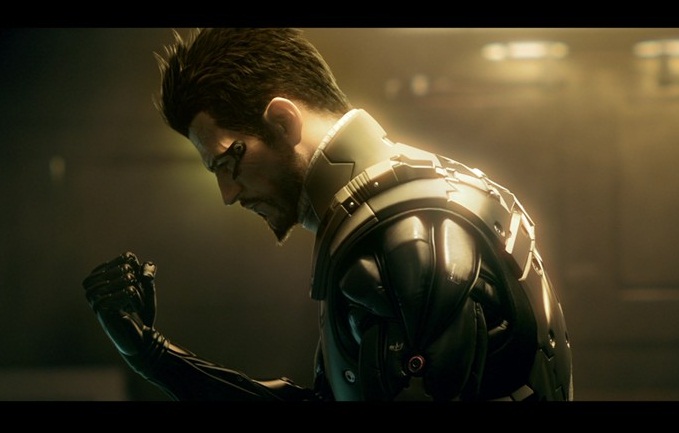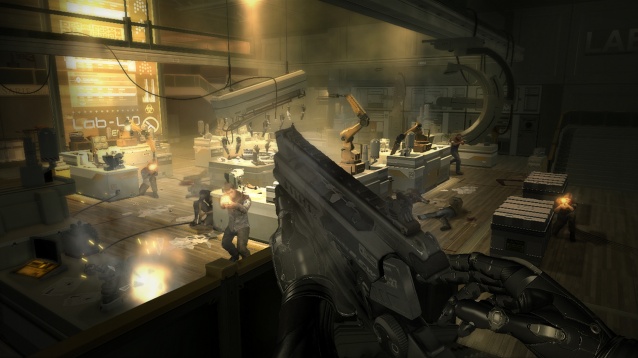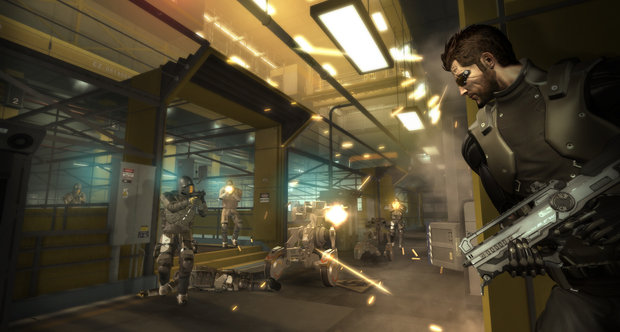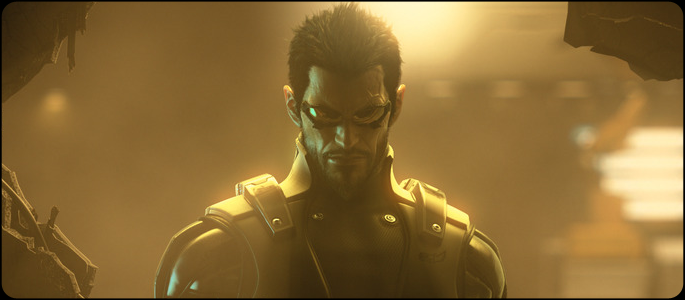Review: Deus Ex: Human Revolution

INTRO
Veteran gamers have long anticipated a current-generation Deus Ex title. The original Deus Ex, released in 2000, is commonly labeled the greatest PC game of all time by fans and industry pundits alike, while the slightly less well-received sequel, Invisible War, amassed scores of new fans from the console crowd. Both were revolutionary in their day, masterfully combining first-person shooter with RPG elements, and remain two of the most memorable games of the previous decade. With Human Revolution, developer Eidos Interactive hopes to re-establish the prestigious franchise’s former relevance after an 8-year industry hiatus. This anxiously awaited prequel preserves the core gameplay mechanics and the uniformly dystopian setting the series is known for, while taking advantage of current-gen hardware to craft an immersive and addictive experience.
STORY
The year is 2027, 25 years before the events in Deus Ex. The era is characterized by humanity’s slow descent into chaos, where our uninhibited foray into biotechnology and cybernetics has engendered a culture of fear and uncertainty among the populace. Human augmentation development is rapidly approaching an existential impasse, and each camp has its share of vehement activists. One side claims that modifying the body will obscure what it means to be human, while defenders endorse the practice for its medicinal applications and the greater good. Control over human enhancement rests with a phalanx of high-profile corporate elite who wish to dictate the course humanity will take in the years to come, all in the name of power and greed. Think 18th century Illuminati escapade hewed to a 21st century context.
You play Adam Jensen, a former Spec Ops veteran whose DNA is found to be uniquely compatible with augmentation technology. Now chief of security for America’s preeminent biotech corporation, an attack on HQ triggers a manhunt for those responsible. As you slowly peel away the conspiratorial layers, you discover the truth is far more extreme than anyone anticipated. Honestly, the plot veers over the top, and the notions of global conspiracies are just as illogical today as they were two centuries ago. In my view, the plot was a bit too banal to be memorable, but the presentation and characters provide just enough motivation to care about how it all plays out. The ending isn’t as noteworthy as I had hoped, though there are four possible depending on your choices.

I should note that knowledge of the happenings in either of the previous Deus Ex titles is unnecessary to understand or fully enjoy the story here. Some lingering questions will be answered for those who have played the other two, but HR‘s story arc is equally intelligible as a stand-alone plot.
GAMEPLAY
Deus Ex is fundamentally about choice. HR fully embraces this core principle by crafting a rewarding experience for creative players. Expect a brilliant mix of stealth and combat mechanics. Indeed, each environment is masterfully designed to accommodate both styles of play. This multifaceted experience is aided in large part by perfect controls which ground you firmly in the game world from start to finish. Controls should never for one second undermine the immersiveness of a game, and this is a flawless example of one that gets it right.
Choosing an all-out assault approach is tempting, as the game packs a diverse mix of lethal and non-lethal weaponry, ranging from SMGs, sniper rifles and mines to stun guns and tranquilizer rifles. Each gun is unique and well-designed and, if you manage your inventory well, you can amass an impressive arsenal by the end of the game. Many are also compatible with upgrades, one notable being the Flechette attachment which, if you lack line of sight of your target, allows your bullets to curve around walls, breaking the laws of physics Wanted-style.

If you choose to stow your weapons instead, a stealth approach can be hugely satisfying, and you’re rewarded handsomely for it. Progressing through entire areas without being spotted or setting off an alarm grants XP bonuses. There are always alternate paths through each guard-laden area just waiting to be discovered.
Both styles are perfectly balanced in a way that makes neither tactic a superior option. Your armor, even on the lower difficulties, feels like a step below Kevlar; a few rounds of repeated fire and you’re looking at a reload screen. Conversely, playing stealthy is never lacking in intensity, as a single errant maneuver can devolve to an all-out firefight if you’re not careful. A more cautious approach when attempting stealth runs prevents trial and error gameplay, though I would unreservedly encourage players to save frequently no matter which approach you choose to take.
The heart and soul of the Deus Ex series has always been the augmentations, and HR’s selection surpasses all expectations. What’s here is so good that it’s difficult to even think of others they could have added. Cloak, super sprint, the ability to see through walls and a 9-feet vertical jump are all here. For non-stealthy players, one aug allows you to takedown an enemy behind a weak wall. Some are very useful depending on your play style, some are merely cool, and some can be both. By investing points in your strength aug, for example, you can either throw a vending machine at your adversaries or instead use it as mobile cover, carrying it around and placing it at will. Imagination is key to the experience.
Expanding your augmentation tree is an addictive process. As you level up, new abilities enable you to explore areas that were previously inaccessible. Depending on the augs you choose, you may not be able to reach every hidden passage, ledge or storage room on the map. Eidos designed the game world in a way that encourages exploration. Environments are intricate, though not overly labyrinthine.
Augs also greatly expand the diversity of tactics you can use to engage your enemies. While you never lose the sense of feeling human, once your aug collection is fully stacked, you can’t help but feel a bit like an Aston Martin in a dog race, a juggernaut fighting mall cops. That said, there’s still a fine line here between playing smart and playing carelessly. The latter will often result in death due to your thin layer of armor.
The hacking minigame in this installment deserves a special mention. It’s a splendidly geeky game of capture and defend where you attempt to capture all of the nodes while defending your I/O port from being detected by the network. If the network successfully traces your entry point, you will be booted from the system and forced to try again. I found it relentlessly addictive in a way that makes the versions in the Fallout and BioShock series seem downright pedestrian. Unfortunately, hacking becomes far too easy once you invest only slightly in your hacking skills, and the complexity of the sequences does not increase as you progress through the game. Level 1 hacks in later stages of the game pose no greater challenge than those earlier on. Once you’re familiar with the system, they start to be a bit too easy, and I found myself craving greater depth later in the game. The in-game tutorial is embedded below.
Rounding out the core mechanics are the social interactions. While certainly nowhere near the level of Mass Effect, you’re provided ample choices based on your dispositional preferences. Whether you prefer to be an arrogant, sarcastic brute or a chivalrous, charming pacifist, the options are there. Some social interactions act as challenges, in which you must select the appropriate dialog options to coerce an NPC to provide information or otherwise take some action that is essential to your cause. These challenges have real consequences and often have a ripple effect on how future events or interactions play out later in the game.
If there’s one knock to be made against HR, it’s irrefutably the boss encounters. To me these only seemed to conflict with the core experience. What’s worse, they cannot be skipped, no matter how stealthily you proceed through the game. One later battle in particular is highly obnoxious (Protip: Do NOT take the “upgraded” biochip when given the option). At the very least, they provide the chance to unleash all the ammo you’ve been hoarding from stealth-based play. Yet in a title that so rewards stealth and ingenuity, forcing you to engage and kill boss characters just seems out of place.
VISUALS
Eidos has managed to effectively capture the dystopian aesthetic here, conveying a volatile and oppressive ambience in every city and within every tucked away eBook. The urban settings are futuristic, yet not too much so (after all, the story is set just 15 years from now). Just like the first two games, the majority of missions take place at night, and the predominantly dark imagery complements the vision of the game.
Detail, detail, detail. Each environment you visit, from Detroit to Singapore, is hyper-detailed, with some vistas approaching photo-realism. The game artists had fun here, and their passion shows. Every object in every room serves a purpose and is interesting to look at, something I can really appreciate. There is some unfortunate repetition among indoor environments, however, and I feel this should have been given more attention.
Human Revolution uses a reworked version of Eidos’ Crystal Engine and, for the most part, delivers a top-notch visual experience. Frame rates are solid overall, as v-sync is auto-enabled for console versions. After multiple playthroughs trying out different techniques, I only experienced slight slowdown during a few heavy combat situations, but frame rates are generally rock solid.

This is one of the first console titles to apply NVIDIA’s FXAA (anti-aliasing) tech, which intelligently blurs the image to increase perceived resolution.
The game also uses real-time shadowing, which should really be a mandatory companion to dynamic lighting these days, as it helps to preserve visual integrity while in motion.
Eidos has included a custom version of screen-space ambient occlusion (SSAO), first used in Crysis in 2007. The shader technology appends an extra layer of depth to the image, giving textures a more refined look. This is perhaps most noticeable while in cover, properly positioning your character in the game space relative to his surroundings.
Unfortunately, the character models and the FMVs in the game are of poor quality, displaying a grainy, low-res look. It’s especially jarring since actual gameplay looks so fresh and detailed. This is likely due to the limited storage capacity on Xbox 360. The poor cutscene quality was regrettably ported over to the PS3 and PC versions of the game as a byproduct of lowest common denominator development. Instead of re-encoding separate, higher resolution FMVs for formats with greater capacity, Eidos optimized the data for the 6.8GB available to the 360 format and dropped it in all three.
Technical details: native 720p v-synced to 30 frame/s (Xbox 360 and PS3)
AUDIO
Audio production values are generally high as well. Weapon effects, your character’s footsteps and augmentation audio cues are all spot-on. While the voice-overs for lesser NPCs could be better, particularly those representing nations outside the U.S., the more essential actors put in a strong performance. The radio and news broadcasts could also be much more varied, as the repetition starts to grate the nerves about midway through the game.
Michael McCann, who also scored the Splinter Cell series, handled the soundtrack. Though some pieces are eerily reminiscent of Mass Effect, McCann achieves a rare symbiosis here which pleasantly syncs with the overall feel of the game. Listen for yourself below.
REPLAY VALUE
My first playthrough clocked in at just under 30 hours. That included completing every side mission, hacking everything in sight and otherwise attaining every shred of XP possible. Even with maximum XP, I wasn’t able to unlock every augmentation, which is OK. The copious aug selection demands additional playthroughs so you can try out new techniques. There are quite a few side missions to complete, many with alternate outcomes. The main missions and aforementioned social challenges add several more permutations, including four different endings to the game. Multiple playthroughs are welcomed to experience everything the game has to offer.
CONCLUSION
The one word that interlaces this review: addictive. Human Revolution offers a refreshing amount of depth not typically experienced outside of traditional open-world RPG titles. After multiple playthroughs and mixing things up on the fly, I can confidently say this is one of the few games where whatever approach you choose delivers an enjoyable experience. The engrossing collection of augmentations and variety of play styles ensure the experience never grows stale.
The attention to detail here is tremendous and personifies a development team committed to uncompromising quality. The seamless controls, arresting visuals, and choice-heavy RPG elements make it difficult to put down. The overarching plot, intermittent boss battles, and low quality cutscenes are definitely low points, but don’t mar the overall experience. Truth be told, this is as close to digital crack as it gets. If you’re even remotely into the shooter genre, pick this one up.



Comments